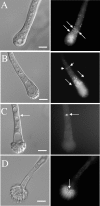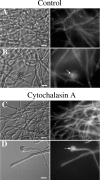Calcineurin localizes to the hyphal septum in Aspergillus fumigatus: implications for septum formation and conidiophore development
- PMID: 18606829
- PMCID: PMC2547068
- DOI: 10.1128/EC.00200-08
Calcineurin localizes to the hyphal septum in Aspergillus fumigatus: implications for septum formation and conidiophore development
Abstract
A functional calcineurin A fusion to enhanced green fluorescent protein (EGFP), CnaA-EGFP, was expressed in the Aspergillus fumigatus DeltacnaA mutant. CnaA-EGFP localized in actively growing hyphal tips, at the septa, and at junctions between the vesicle and phialides in an actin-dependent manner. This is the first study to implicate calcineurin in septum formation and conidiophore development of a filamentous fungus.
Figures




References
-
- Cyert, M. S. 2003. Calcineurin signaling in Saccharomyces cerevisiae: how yeast go crazy in response to stress. Biochem. Biophys. Res. Commun. 3111143-1150. - PubMed
Publication types
MeSH terms
Substances
Grants and funding
LinkOut - more resources
Full Text Sources
Molecular Biology Databases

